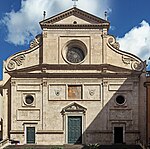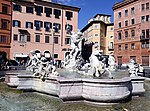Sant'Apollinare, Rome
18th-century Roman Catholic church buildings in Italy7th-century churches in ItalyBaroque architecture in RomeBasilica churches in RomeChurches of Rome (rione Ponte) ... and 2 more
Renaissance architecture in RomeTitular churches

The Basilica di Sant'Apollinare alle Terme Neroniane-Alessandrine ("Basilica of Saint Apollinaris at the Baths of Nero") is a titular church in Rome, Italy, dedicated to St Apollinare, the first bishop of Ravenna. It is the station church for the Thursday of the fifth week in Lent.
Excerpt from the Wikipedia article Sant'Apollinare, Rome (License: CC BY-SA 3.0, Authors, Images).Sant'Apollinare, Rome
Piazza di Sant'Apollinare, Rome Municipio Roma I
Geographical coordinates (GPS) Address External links Nearby Places Show on map
Geographical coordinates (GPS)
| Latitude | Longitude |
|---|---|
| N 41.900888888889 ° | E 12.473611111111 ° |
Address
Basilica di Sant’Apollinare alle Terme
Piazza di Sant'Apollinare
00186 Rome, Municipio Roma I
Lazio, Italy
Open on Google Maps










